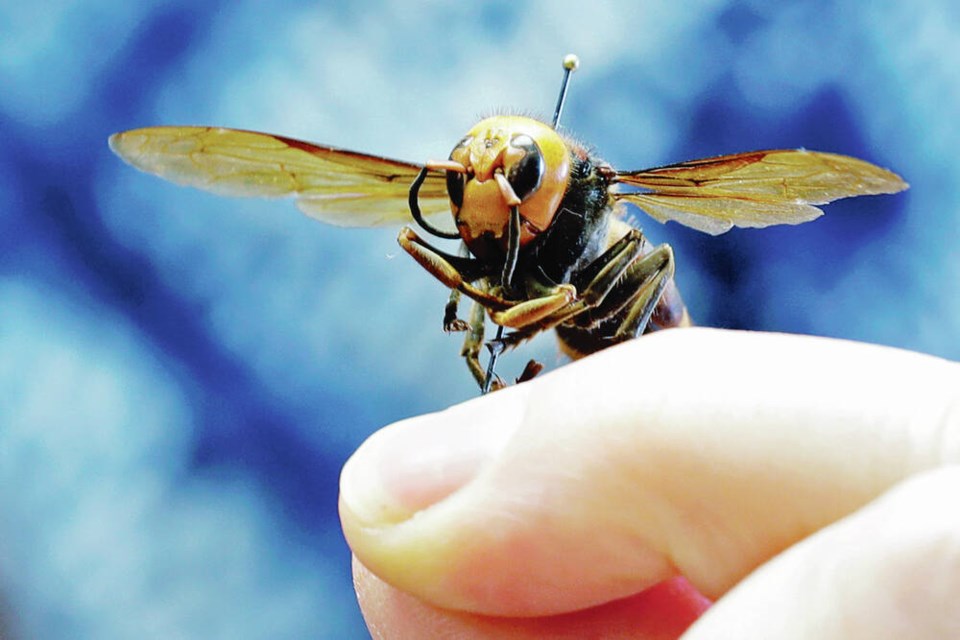The invasive hornet formerly known as the “murder hornet” and the “Asian giant hornet” has a new identity. As recently reported in these pages, the Entomological Society of America has designated “northern giant hornet” as the wasp’s new English common name.
The society’s decision avoids both the overly dramatic and the ethnic associations of the names we’ve been calling the hornet since it was found nesting in a Nanaimo park three years ago. The new name also aligns with the society’s guidelines that bar common names for insects referring to ethnic or racial groups, or that could stoke fear.
Common names for plants and animals are used locally and may vary by region or country. The U.S. entomological society began recognizing insect common names in the early 20th century to help bridge communication between those who study bugs and, well, everyone else.
This is not the first name overhaul the society has undertaken. In March, it introduced the new common name “spongy moth” for the invasive moth previously known as gypsy moth. For the ethnic Romani people, the word “gypsy” has been offensive, dangerous and dehumanizing since it first appeared in the 1500s.
Of course, we can always call organisms by their scientific names. Scientific names are unique to each species and are used — primarily by the scientific community and, I’ve noticed, really avid gardeners — to accurately and universally identify species.
The spongy moth’s scientific name is Lymantria dispar. The northern giant hornet’s is Vespa mandarinia.
“Vespa” is the Latin (and Italian) word for “wasp” and signals the giant hornet is closely related to yellowjackets, paper wasps, bald-faced hornets and other wasps. When referring to that group, or genus, Vespa is always capitalized.
The name has a long, honourable pedigree. Carl Linnaeus, the father of modern taxonomy who designed the two-name system for naming organisms, chose “Vespa” in the 1750s.
The second part of the name, “mandarinia,” was coined by Frederick Smith, the British Museum employee who published the first-known scientific description of the species back in 1852. He described Vespa mandarinia in the paper, “VIII. Descriptions of some new and apparently undescribed species of hymenopterous insects from North China, collected by Robert Fortune, Esq.,” published in the Transactions of the Royal Entomological Society of London.
The choice, selection and approval of scientific names is governed by lengthy and strict universally accepted codes that are laboriously and infrequently updated by members of the relevant international scientific committees. Animal names are regulated by the International Committee on Zoological Nomenclature (i.e., the international committee on animal naming). Other similar committees deal with names for plants, fungi, bacteria and so on.
Scientific names include or borrow heavily from Latin and Greek. Elements of other languages are either translated into Latin or Greek or given Latinate or Greek-like endings. For example, if Nature Boy were determined to be his own unique species, the name submitted to the animal-naming committee might be Puer (“boy” in Latin) naturalis.
These days, the Latin/Greek requirement could be considered non-inclusive and discriminatory.
Of course, “mandarinia” itself refers to those Asian antecedents that the Entomological Society of America is trying to avoid with the insect’s new common name.
Dig into the background of many scientific names, and other issues may emerge. For example, Smith, who coined “Vespa mandarinia” in 1852, was an elite (educated) member of a patriarchal, colonizing society, Britain. The specimen he described was collected by Robert Fortune, Esq., another elite (wealthy, educated) member of the same society, from a region populated and governed by peoples of colour who were, at the time, considered inferior and therefore colonizable by Smith and Fortune’s society.
Even in scientific names, layer upon layer of thorny undertones exist.
And the day-to-day use of scientific names brings other problems. Liberal use of Latin and Greek at, say, at the grocery store adds to the likelihood of getting blank or confused looks or having eyeballs rolled at you in response.
In other words, it’s a quick and effective way to come across as a pretentious wonk.
All of this is to say that if even enough of us opt to use “Vespa mandarinia” often enough that the scientific name becomes the commonly used — and understood— name, we’d still be dealing with a host of issues inherent in scientific naming conventions and the name itself.
keiran_monique@rocketmail.com



